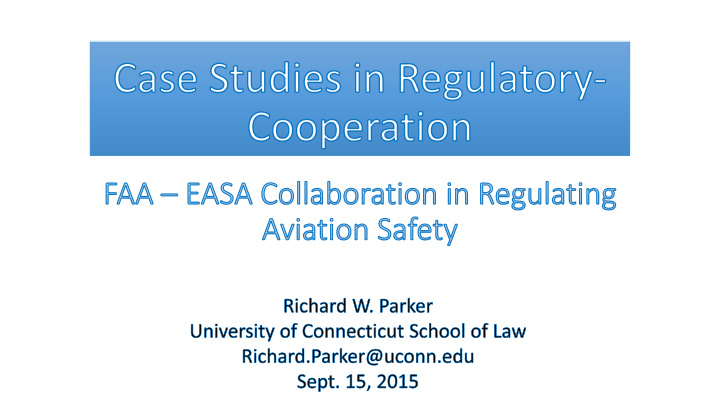



The Key Players • US Federal Aviation Administration (FAA) • DG-Move/European Aviation Safety Agency (EASA) • EU Member State National Aviation Safety Authorities • Aircraft Manufacturers • Public Interest Advocacy Groups (Minor role)
Goals of Cooperation • Aviation Safety, first and foremost • Reduced regulatory costs • Reduced compliance costs • Enhanced public confidence in process and outcome
Main Modes of Cooperation • Certification – Reciprocal acceptance of exporting state certification of compliance with importing state aviation safety requirements • Rulemaking -- Coordination of aviation safety requirements • Also (not studied) -- • Pre- and post-regulation data sharing • Accident investigations
Foundational requirements of regulatory cooperation -- • Named points of contact endowed with sufficient authority to assure compliance of state and non-state actors • Comprehensive access to data, including proprietary data, needed for rulemaking/certification
Overview of Process for Cooperation in Type- Certification of New Models of Aircraft • Certification is the door through which all trade in aviation products passes. • US-EU cooperation is governed by US-EU Bilateral Aviation Safety Agreement (BASA), which replaces FAA’s prior BASAs with Member States. • It’s a lengthy document with a key annex governing certification that has gone through five major revisions.
Key Provisions of BASA on reciprocal acceptance of airworthiness certifications • Core understanding is that the exporting country regulator is certifying conformity with the importing party’s requirements . • Certification is a shared labor in which national regulators accept foreign conformity assessments for the majority of issues, but retain domestic supervision over novel or complex “Validation Items.”
Reciprocal acceptance requires mutual confidence • Confidence is grounded initially in a history of reciprocal inspections and audits conducted by FAA and EASA in the territory of the other party, and aimed at verifying the technical and institutional capacity of foreign regulators to provide credible certifications. • These audits and inspections apply to Member States who still play role in certification process.
Mutual confidence is not yet complete 1. FAA will not yet delegate to EASA responsibility for validating the capacity of Member State regulators to provide credible certifications of regulatory capacity in new product areas (e.g. the case of Spanish helicopters) 2. Both sides retain right to independently certify “Validation Items.” 3. Goal is that number and frequency of retained- jurisdiction Validation Items will diminish over time as mutual confidence grows.
Approach to Mutual Recognition embodied in Aircraft Certification Cooperation • Significantly, FAA and EASA do not approach “mutual recognition” (aka “reciprocal acceptance”) of foreign standards via rulemaking or guidance issued in the abstract. • Rather, they embed these decisions in individual type- certification reviews. This allows regulators to make determinations of regulatory equivalence in context of a examination of the totality of a particular design.
Overview of US-EU Rulemaking Cooperation • While US-EU regulatory cooperation in type- certification is long-standing, rulemaking collaboration is more recent and much less structured. • FAA and EASA have undertaken 4 pilot projects in rulemaking cooperation. • I reviewed one of these as a case study: Reorganization of Part 23/CS 23 rule setting forth civil (i.e. non-commercial) aircraft airworthiness requirements.
Key points on rulemaking cooperation (I) • Regulatory cooperation in rulemaking logically might entail (1) joint rulemaking procedures, or (2) parallel and concurrent rulemakings. • FAA and EASA have chosen the latter approach. • Means two rulemakings conducted side by side with goal of making each rulemaking come out the same way – which is obviously rather inefficient
Consultation is done principally through reciprocal participation in each other’s rulemaking advisory committees • Each side sends “observers” to participate in the rulemaking advisory committees or drafting groups of the other side. • This approach integrates foreign consultations into the domestic rulemaking process of each side, while providing an efficient forum for each partner to seek input from other major regulators (e.g., Canada, China and Brazil) at the same time.
This approach works well due to high reliance on advisory committees in rulemaking process Advantages Leverages agency resources with industry and foreign government expertise Builds political buy-in for the requirements that emerge from the process Allows repeated interactions -- in person and by phone and email – among stakeholders, which elevates importance of reputation and builds trust.
Disadvantages of advisory committee approach as implemented by FAA -EASA • Industry-dominated on both sides • Not very transparent -- While the Aviation Rulemaking Advisory Committee (ARAC) is subject to the transparency provisions of FACA, FAA’s Aviation Rulemaking Committees (ARCs) enjoy a special exemption from FACA. • ARCs do their work largely out of sight before FAA even issues the Regulatory Action Plan (RAP) that clues in the public that a rulemaking is afoot.
FAA ex parte rules further encumber cooperation • While huge amounts of advisory committee work take place essentially in secret before the RAP, after the RAP the FAA brings down the curtain on candid, ex parte communication after that point. • Foreign governments, including EASA, are subject to this ban like everyone else. So they are impeded from talking to each other as they respond to comments on their draft rule received from their respective publics.
A better approach would apply the following principles 1. Throughout the rulemaking process, national co- regulators should be allowed to treat conversations with each other the same way they treat conversations with their own staff. 2. When they seek advice from outside stakeholders and the public their advisory committees and working groups should be open, balanced, and broadly representative of key stakeholders.
Recommend
More recommend